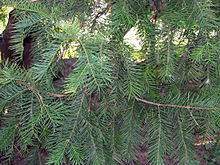Torreya
| Torreya Temporal range:
| |
|---|---|

| |
| Torreya nucifera | |
| Scientific classification | |
| Kingdom: | Plantae |
| Clade: | Tracheophytes |
| Clade: | Gymnospermae |
| Division: | Pinophyta |
| Class: | Pinopsida |
| Order: | Cupressales
|
| Family: | Taxaceae |
| Genus: | Torreya Arn.
|
| Type species | |
Arn.
| |
| Species | |
| |
| Synonyms | |
Torreya is a genus of
The genus is one example of the
The leaves are spirally arranged on the shoots, but twisted at the base to lie in two flat ranks; they are linear, 2–8 cm long and 3–4 mm broad, hard in texture, with a sharp spine tip.
Torreya can be
The genus is named after the American botanist John Torrey.
Fossil record

†
Fossil pollen of genus Torreya and other genera within Taxaceae is generally deemed indistinguishable, one from another, and also from genera within families Taxodiaceae and Cupressaceae.[12] Therefore, it is generally difficult to support past presence or absence of such genera in geographic locales where macrofossil plant material is rare or absent, even if substantial pollen (as in Quaternary bogs) is available.
Adaptive growth forms of this subcanopy genus
Species within this genus are all adapted to establish and grow slowly as subcanopy woody plants in forest habitats of moderate to dense shade. Stems will lean in very shady conditions, with branches and additional stems arising from the root crown growing more horizontally than vertically. If and when a canopy opening occurs, upward growth will be stimulated and even the leaf form and orientation will shift.[13]
Seed production occurs on female branches (and trees) only in the presence of direct sunlight. Therefore, wild trees tended and planted trees cultivated for local or market seed consumption in Asia (usually, Torreya grandis) will have their surroundings managed accordingly through human intervention.
Species
| Phylogeny of Torreya[14][15] | |||||||||||||||||||||||||||||||||||||||
|---|---|---|---|---|---|---|---|---|---|---|---|---|---|---|---|---|---|---|---|---|---|---|---|---|---|---|---|---|---|---|---|---|---|---|---|---|---|---|---|
|
| Image | Scientific name | Common Name | Distribution | Description |
|---|---|---|---|---|
 |
Torreya californica | California torreya | California, USA | It is the largest of the two species in North America. |
| Torreya fargesii | Farges nutmeg tree | China: Hubei, Hunan, Jiangxi, Shaanxi, Sichuan, and Yunnan provinces, and possibly in Anhui | ||
 |
Torreya grandis | Chinese nutmeg yew | China: Fujian, Zhejiang, Jiangsu, Anhui, Guizhou, Hunan, and Jiangxi | Cultivated extensively for its edible seed, and as an ornamental plant. |
| Torreya jackii | Jack's nutmeg tree, longleaf torreya, Jack torreya, and weeping torreya | China, in Zhejiang, Fujian, and Jiangxi provinces | ||
 |
Torreya nucifera | kaya, Japanese torreya, or Japanese nutmeg-yew. | southern Japan and to South Korea's Jeju Island | |
 |
Torreya taxifolia | Florida torreya or gopher wood | restricted habitat within Florida Panhandle and immediately adjacent southernmost Georgia |
Limited to its peak glacial refuge, this species became the type example of "assisted species migration" for climate-endangered forest trees when a citizen group, Torreya Guardians, began planting it more than 600 kilometers poleward. |
References
- JSTOR 2804665.
- hdl:10138/28914.
- S2CID 42399351. Retrieved 6 January 2022.
- S2CID 92584722.
- S2CID 135444698.
- ^ Eckenwalder, J.E. 2009. Conifers of the World: The Complete Reference. Timber Press.
- S2CID 44006384. Retrieved 19 July 2021.
- ^ "Torreya nucifera / Japanese nutmeg-yew". American Conifer Society. Retrieved 19 July 2021.
- ^ "About Torreya taxifolia". Torreya Guardians. Retrieved 19 July 2021.
- ^ Manchester, S.R. (1994). "Fruits and Seeds of the Middle Eocene Nut Beds Flora, Clarno Formation, Oregon". Palaeontographica Americana. 58: 30–31.
- ^ The early Miocene flora of Güvem (Central Anatolia, Turkey): A window into early Neogene vegetation and environments in the Eastern Mediterranean by Thomas Denk, Tuncay H Güner, Zlatko Kvaček and Johannes M Bouchal - Acta Palaeobotanica 2017 - DOI: 101515/acpa-2017-0011
- S2CID 213484283.
- ^ Barlow, Connie. "Torreya californica (California torreya)". Torreya Guardians. Retrieved 18 June 2022.
- S2CID 232282918.
- )


